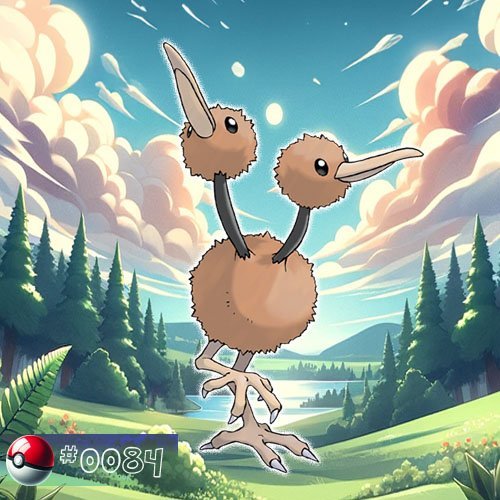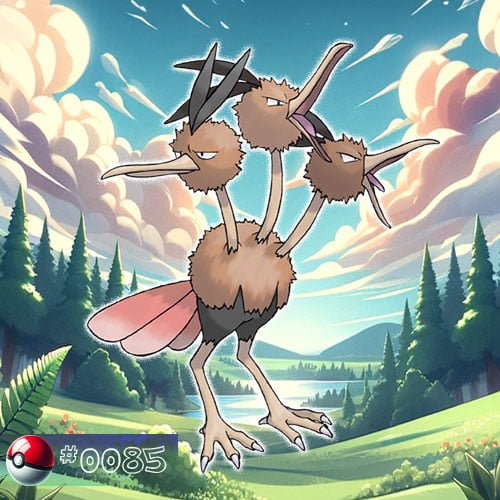Doduo
Doduo is a Normal/Flying-type Pokémon. It’s a bird-like Pokémon known for having two heads, each with its own brain. Doduo is characterized by its fast running speed and is capable of running long distances without tiring. It evolves into Dodrio starting at level 31.
Biology
Physical Characteristics
Doduo is a dual-type Normal/Flying Pokémon species that was introduced in the first generation of Pokémon games. Here are the physical characteristics of Doduo.
Doduo is a bird Pokémon characterized by its unique two-headed appearance. Each head of Doduo has a long, pointed beak that is slightly curved. The beaks are strong and sharp, allowing Doduo to grasp and manipulate objects with precision. Doduo often has distinct facial markings around its eyes and beaks, adding to its overall aesthetic. These markings may vary slightly between individual Doduo.
Doduo’s eyes are large and round, allowing for excellent vision. Its binocular vision from having two heads enhances depth perception, making Doduo adept at spotting prey or potential dangers. The color of Doduo’s eyes may vary, commonly appearing as dark or black, complementing its overall color scheme.
The feathers covering Doduo’s body are soft and provide insulation. These feathers can vary in texture, with some areas having downy feathers for added warmth. While the primary coloration is brown, Doduo’s feathers may have subtle variations and patterns, contributing to its visual appeal.
Doduo’s legs are robust and muscular, enabling it to achieve remarkable running speeds. The strength in its legs also supports its ability to cover long distances without tiring easily. Each foot has three talon-tipped toes, providing Doduo with stability and a firm grip on various surfaces.
Doduo has a streamlined, aerodynamic body shape, which reduces air resistance as it runs. This adaptation contributes to its impressive running speed. Despite its robust appearance, Doduo is relatively lightweight, optimizing its agility and allowing for rapid acceleration.
Upon evolving into Dodrio, Doduo gains a third head and an additional pair of wings. The third head contributes to enhanced awareness, and while Dodrio still cannot achieve sustained flight, it gains improved jumping and gliding abilities.
These more detailed characteristics provide a comprehensive view of Doduo’s physical attributes, showcasing its evolutionary adaptations, social behaviors, and unique anatomical features within the Pokémon world.
Behaviour
Doduo’s behavior is influenced by its unique physical characteristics and its role in the Pokémon ecosystem. Here are detailed aspects of Doduo’s behavior.
Doduo is known to form small groups or flocks. Within these groups, individuals work cooperatively, sharing responsibilities such as keeping watch for predators and coordinating movements during activities like hunting or migration.
Doduo is capable of producing distinct vocalizations. These sounds are used for communication within the group, signaling danger, coordinating actions, or expressing other emotions. Beyond vocalizations, Doduo’s body language, including the movement of its heads and posture, plays a crucial role in non-verbal communication within the group.
Doduo may engage in territorial behavior, marking its habitat using a combination of vocalizations, visual displays, and scent markings. This serves to establish boundaries and communicate with other nearby groups.
Doduo is primarily herbivorous, feeding on berries, seeds, and other plant-based food sources. However, it may also consume small insects or invertebrates. When Doduo hunts, its group may employ cooperative strategies, surrounding and corralling prey using their speed and coordinated movements.
Doduo is an extremely active Pokémon, and its high energy levels are channeled into running. The species engages in frequent running exercises, both as a means of staying fit and as a form of play. Doduo, like many Pokémon, engages in nesting behavior. The female Doduo is responsible for building nests, which are often placed in hidden locations to protect eggs from potential predators.
Both male and female Doduo take turns incubating the eggs and caring for the chicks after hatching. The cooperative effort in parenting aligns with Doduo’s overall social structure. Doduo exhibits a strong instinct for protecting its group members. When faced with threats, the heads may signal danger, and the entire group may respond by either fleeing or standing their ground to defend against predators.
Doduo may interact with other Pokémon species, both positively and negatively. It might form symbiotic relationships with certain Pokémon or engage in territorial disputes with others. Doduo may exhibit curiosity towards humans but is generally cautious. In the wild, it might observe human activities from a distance, especially if humans are within their territory.
While Doduo is diurnal (active during the day), it may rest during the night. The ability to rest helps conserve energy for the next day’s activities.
Understanding Doduo’s behavior provides insights into its survival strategies, social dynamics, and ecological role. These behaviors contribute to the overall richness and complexity of Doduo’s existence in the Pokémon world.
Evolution
Doduo undergoes a single-stage evolution into Dodrio. Here are the details of Doduo’s evolution.
Doduo is a dual-type Normal/Flying Pokémon and is known for its distinct two-headed appearance. As previously described, Doduo has a brown, bird-like body with two heads, each featuring a long neck and a pointed beak. It has small, vestigial wings that do not allow for flight. Doduo evolves into Dodrio when it reaches level 31. This evolution is triggered by gaining experience points through battles, training, or using certain items like Rare Candies.
Dodrio is also a dual-type Normal/Flying Pokémon, maintaining its Flying-type from Doduo. The most notable change in Dodrio is the emergence of a third head, creating a tri-headed structure. Dodrio also gains an extra pair of wings, although it is still unable to achieve sustained flight.
Dodrio’s three heads provide it with enhanced awareness, allowing it to observe its surroundings from multiple angles simultaneously. The additional pair of wings on Dodrio’s body is larger than the vestigial wings on Doduo. While Dodrio still can’t fly in the traditional sense, it gains improved jumping and gliding abilities.
With the addition of a third head, Dodrio’s coordination abilities are enhanced. This can be advantageous in group activities, hunting, and navigating its environment. While Dodrio remains primarily grounded, it can use its wings for short flights, allowing it to cover short distances by gliding. This provides Dodrio with an additional mode of mobility compared to Doduo.
Dodrio generally experiences an increase in its base stats upon evolution, making it stronger and more resilient compared to Doduo. Dodrio may learn new moves or abilities upon evolution, expanding its tactical options in battles.
Dodrio’s evolution into Dodrio enhances its versatility in battles and other Pokémon-related activities. Trainers may find Dodrio to be a valuable addition to their teams due to its improved capabilities. In the Pokémon world, the evolution of Doduo into Dodrio is often seen as a testament to the species’ adaptability and survival traits. The addition of a third head is a fascinating aspect of Dodrio’s evolution that captivates trainers and researchers alike.
Understanding Doduo’s evolution into Dodrio provides trainers with insights into the species’ growth, adaptation, and the unique features that emerge as it progresses through its life cycle.
Appearances
Anime Main Appearances
In the episode “Bad to the Bone”, Otoshi utilized his Doduo to fend off Team Rocket. Unfortunately, his efforts took a downturn as Doduo’s two heads turned on each other, causing a chaotic situation. Ultimately, Otoshi had no choice but to recall Doduo due to the internal conflict between its heads.
Anime Minor Appearances
Doduo made its first appearance in “Showdown at the Po-ké Corral” as part of Gary’s Pokémon team. A brief glimpse of Doduo was captured at Professor Oak‘s laboratory during that time. Subsequently, in “Putting the Air Back in Aerodactyl!”, it was disclosed that Doduo had evolved into Dodrio.
Doduo also makes appearances across various Pokémon episodes and movies, engaging in different roles and scenarios. From being at the Pokémon Theme Park (”Pikachu’s Vacation”) to participating in cast for the movie Pokémon in Love in ”Lights, Camera, Quack-tion”, sensing disturbances in ”The Power of One”, and residing in different locations like Palmpona (”Tricks of the Trade”) and Wings Alexander’s barn (”Throwing in the Noctowl”), Doduo’s presence is diverse.
It’s seen in flashbacks (”Poetry Commotion!”, ”Sweet Baby James”, ”Till We Compete Again!”), contests, and as a means of transportation in different contexts throughout the Pokémon series, showcasing its versatility and adaptability in various situations.
Multiple Doduo appeared in the espiodes:
- ”Destiny Deoxys” (in the opening sequence)
- ”Mega Evolution Special III” (multiple Trainers’ Doduo)
- ”Enter Pikachu!” (in a flashback)
- ”Distant Blue Sky!” (six of them umped out of a bush near the Cerise Laboratory)
A Coordinator’s Doduo participated in the Terracotta Contest in the episode ”Once More With Reeling!”.
A Trainer’s Doduo appeared also in the following epsodes:
- ”An Old Family Blend!” (Lily of the Valley Conference)
- ”Forming a More Perfect Union!”
- ”Thank You, Alola! The Journey Continues!”
- ”Betrayed, Bothered, and Beleaguered!”
Manga Appearances
Pokémon Adventures
In “Sigh for Psyduck”, it is revealed that Mr. Fuji’s Doduo had passed away from old age. Unfortunately, it couldn’t be properly laid to rest due to a haunting ghost in the Pokémon Tower. After Red and Blue successfully defeated the ghost and Koga, Mr. Fuji’s Doduo was finally able to find peace.
In “The Jynx Jinx”, a Doduo made a brief appearance as a silhouette when Green discussed Mew. Before her debut in “Do do that Doduo”, Yellow received a Doduo that later evolved in “The Might of… Metapod?!”. It was unveiled in “Tyranitar War” that her uncle, Fisherman Wilton, was the one who gave her the Doduo. Additionaly a tourist’s Doduo made an appearance at the Mini-game Corner in “Sylveon Enchants”.
Pokémon Pocket Monsters
Blue possesses a pair of Doduo, showcased in “Getting The Flying Machine!!,” where he utilized them for flight transportation, lifting himself and his Blastoise.
In “Fierce Competition at the Pokémon Baseball Tournament!,” a Doduo actively participated in a baseball match, joining other Pokémon for the game. It was spotted alongside Green during the tournament.
Various Doduo made an appearance in “The Legendary Moltres Appears!!”, ”Pikachu’s Birthday Party”, “Pokémon Hair Salon Opens!!” (owned by Giovanni).
Doduo also appeared in the following Pokémon manga:
Magical Pokémon Journey – in the episodes ”How Do You Do, Pikachu?” and ”Panic at the Cherry Blossom Festival”.
Pokémon Gold & Silver: The Golden Boys – in the episode ”Let’s Aim For The Goal!”.
Pokémon Gotta Catch ‘Em All – in the episode ”The Challenge at Celadon University!”.
Pokémon Ruby-Sapphire– in the episode ”I Won’t Let You Lead!!”.
Pokémon Zensho – in the the fifth chapter of the Pokémon Zensho manga, PZ06. Also in this manga Shigeru, the rival of Satoshi, has a Doduo, captured in the Safari Zone.
Game data
Stats
Location
| Game version | Location |
|---|---|
| Pokémon Red and Pokémon Blue | Routes 16, 17, and 18, Safari Zone |
| Pokémon Yellow | Routes 16, 17, and 18 |
| Pokémon Gold and Pokémon Silver | Routes 22, 26, 27, and 28, Mt. Silver |
| Pokémon Crystal | Routes 22, 26, 27, and 28, Mt. Silver |
| Pokémon Ruby and Pokémon Sapphire | Safari Zone |
| Pokémon FireRed and Pokémon LeafGreen | Routes 16, 17, and 18, Safari Zone |
| Pokémon Emerald | Safari Zone |
| Pokémon Colosseum | Trade |
| Pokémon XD | Trade |
| Pokémon Diamond and Pokémon Pearl | Route 201 |
| Pokémon Platinum | Route 201 |
| Pokémon HeartGold and Pokémon SoulSilver | Routes 22, 26, 27, and 28, Mt. Silver, Safari Zone |
| Pokémon Black and Pokémon White | Route 12 |
| Pokémon Black 2 and Pokémon White 2 | Route 12 |
| Pokémon X and Pokémon Y | Route 5, Friend Safari |
| Pokémon Omega Ruby and Pokémon Alpha Sapphire | Safari Zone |
| Pokémon Sun and Pokémon Moon | Pokémon Bank |
| Pokémon Ultra Sun and Pokémon Ultra Moon | Pokémon Bank |
| Pokémon: Let's Go, Pikachu! And Pokémon: Let's Go, Eevee! | Routes 16, 17, and 18 |
| Pokémon Sword and Pokémon Shield | Unobtainable |
| Pokémon Brilliant Diamond and Pokémon Shining Pearl | Route 201, Spacious Cave, Grassland Cave, Sunlit Cavern |
| Legends Arceus | Unobtainable |
| Pokémon Scarlet and Pokémon Violet | Trade |
Doduo's origin name
The name “Doduo” is consistent across various languages, maintaining its general pronunciation and often incorporating elements related to its dual-headed nature or its swift and nimble characteristics. Here are the English and several other language names for Doduo:
English: Doduo – The English name “Doduo” likely derives from the words “double” or “duo,” emphasizing the Pokémon’s dual-headed structure.
Japanese: ドードー (Dodo) – In Japanese, Doduo is called “Dodo,” a term that may be associated with the extinct flightless bird known as the dodo. The choice of this name might be due to Doduo’s inability to fly despite having wings.
German: Dodu – The German name for Doduo is “Dodu,” which maintains the phonetic similarity to its English counterpart.
French: Doduo – The French name for Doduo is also “Doduo,” staying true to the original English name.
Spanish: Doduo – In Spanish, Doduo retains its English name, being called “Doduo.”
Italian: Doduo – Similarly, in Italian, Doduo is known by the same name, “Doduo.”
Korean: 두트리 (Dudeuri) – The Korean name for Doduo is “Dudeuri,” which seems to be a transliteration of the English name.
Chinese (Simplified): 嘟嘟 (Dūdū) – In Simplified Chinese, Doduo is referred to as “Dūdū,” which is a phonetic representation of its English name.
Chinese (Traditional): 嘟嘟 (Dūdū) – The Traditional Chinese name for Doduo is also “Dūdū,” mirroring the Simplified Chinese version.
These variations in names across languages often aim to preserve the key aspects of Doduo’s identity, such as its dual-headed nature or its bird-like characteristics. The names may also reflect linguistic considerations and cultural nuances in each region.




